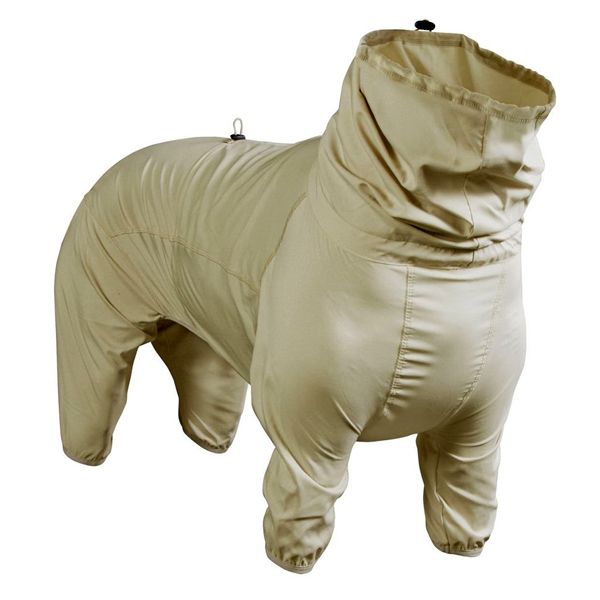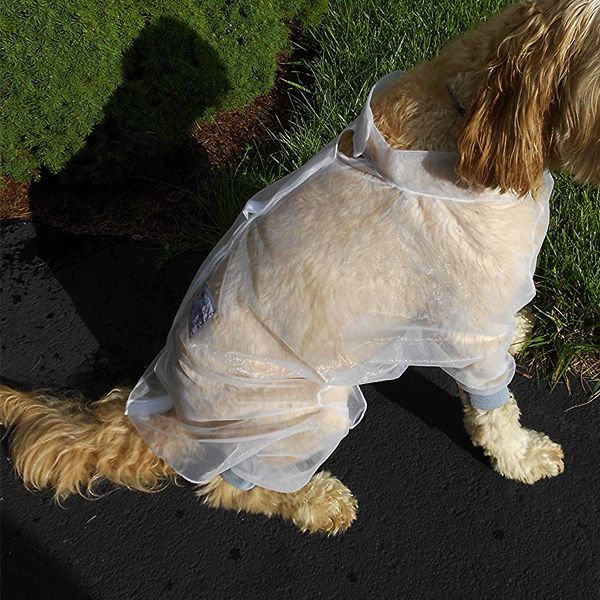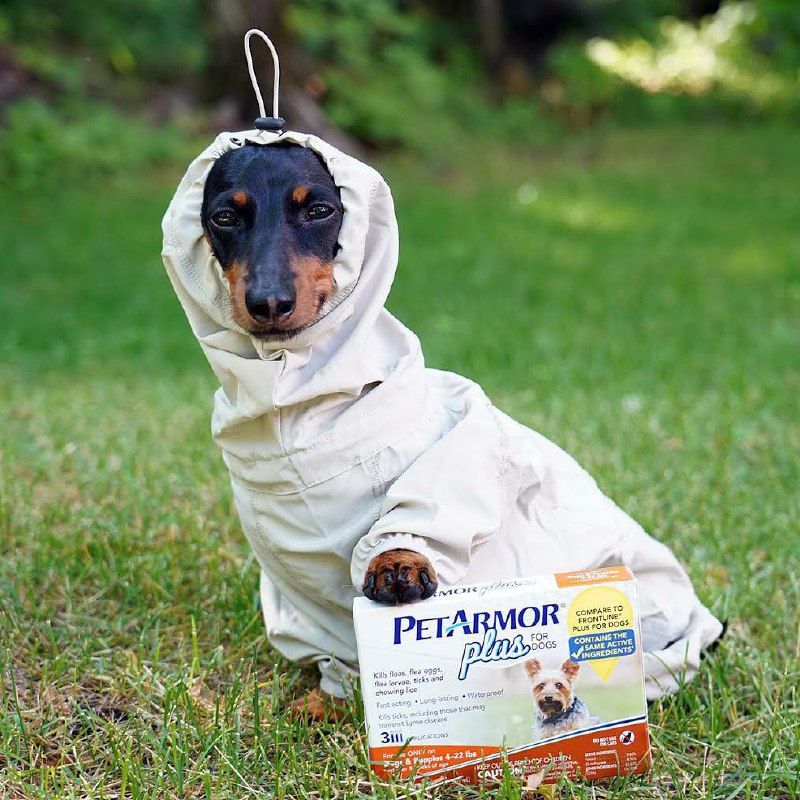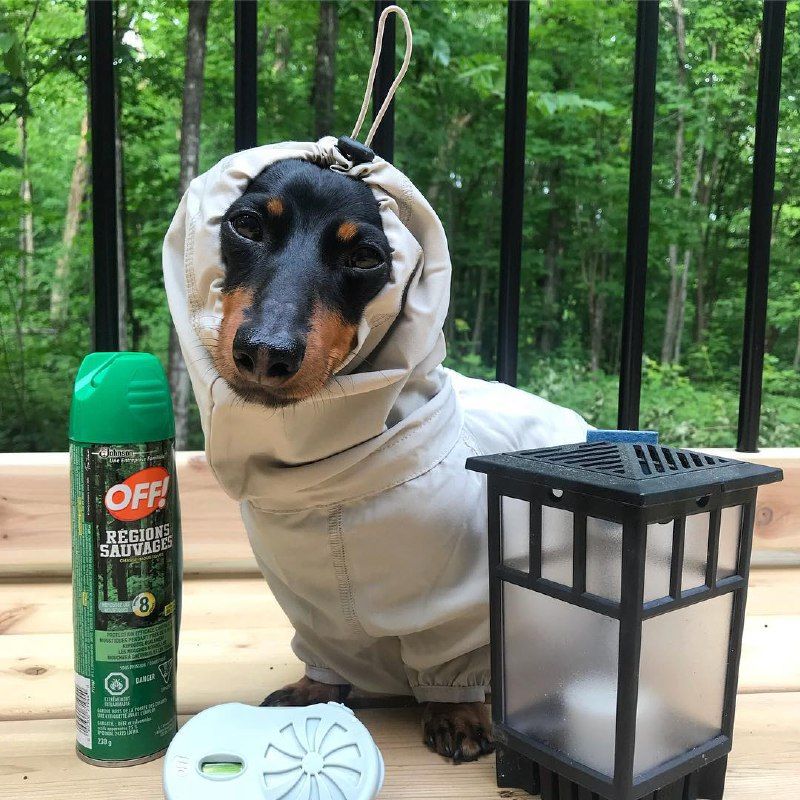Today I’ll tell you about famous beekeepings dogs:
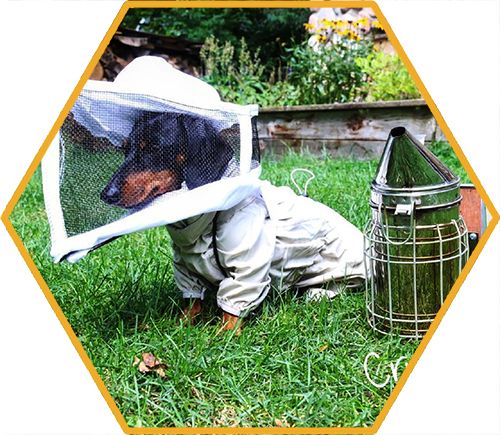
Crusoe – the celebrity dachshund
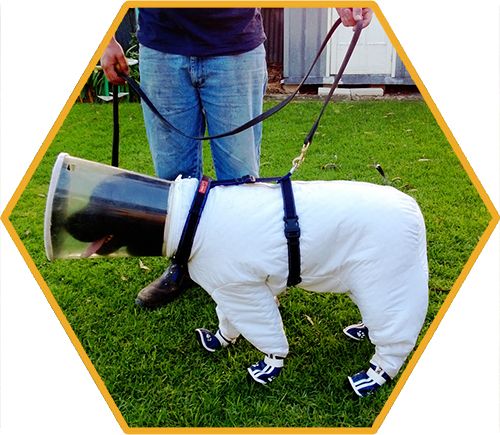
Bazz – beekeeping dog in astronaut suit meme

Klinker – the only dog certified to detect American foulbrood

Mack – the bee sniffling dog
But, one thing at a time.
Crusoe – the celebrity dachshund
A photo of a black dachshund in a dog bee suit is most often found when searching “beekeeping dog”. Meet Crusoe – the celebrity dachshundб who knows how to start beekeeping. However, it is worth noting that, despite the celebrity, dachshund owners are passionate about beekeeping, Crusoe’s apparel is rather make-believe dog beekeeper suit than real protective clothes. Crusoe is just a guest on the apiary. Dachshund is famous for posing in dozens of outfits – the dog’s bee suit is also not an exception, although it looks very natural and by the look, bee veil may protect the dog’s snout from bees. This is a custom homemade beekeeping suit for a dog, not available for purchase.
Despite the decorations, Crusoe still has a real dog protective suit. The owners claim to use it to avoid fleas and ticks during walks in the woods. I managed to find out that this is a Hurtta, professional dog clothes brand. This suit is made of breathable material similar to a fishing shirt. But the main feature is a permethrin-based repellant built in to protect the dog from insects. They have different sizes for any dog – it seems to me that this is a must-have for dog owners.
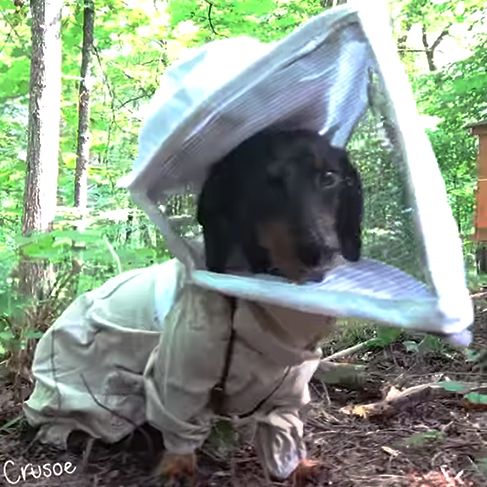
Bazz – beekeeping dog in astronaut suit meme
Welcome Bazz, the black Labrador retriever from Australia, not just a famous beekeeping dog in astronaut suit meme – he received stringent training to sniff out and recognize the American foulbrood. But there still was a problem – Bazz should stay out of the beehives to keep from bee stings.
In the United States, where beehives become snowcapped, bees stay inside during the cold season and it enables to sniff the hives safely. But the warm Australian climate allows bees running year-round, making it almost impossible for Bazz to inspect it.
So, Josh Kennett, Bazz’s employer, has designed a special dog bee suit, completed with bee veil protect dog’s head.
To make Bazz feel comfortable wearing dog beekeeper suit is still an issue – dogs hate uniforms as well as any clothes, especially in sweltering days. Fortunately, Bazz is a quick learner and hard worker, so the inspections take less time. In fairness, Bazz is making an excellent American foulbrood detection without any bee sting.
This dog beekeeping suit is also homemade. But I have some solutions of how to protect your dog from the bees, it will be described below.
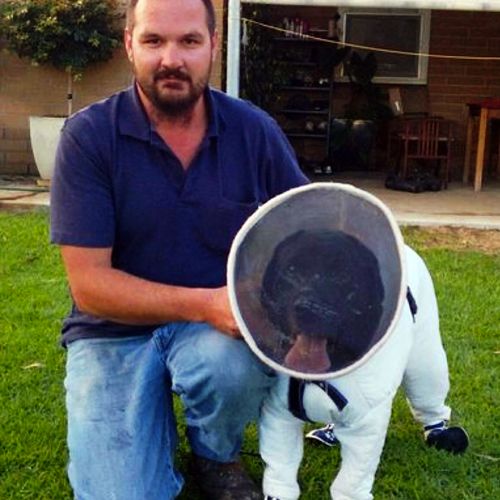
Reasonable beekeeping without gloves example ?
Klinker- the only dog in the continental US, certified to detect American foulbrood
Even in a small amount of disease in a bee colony, Klinker, black Labrador retriever, is going to detect that long before a human would ever be detected. Klinker inspects these for the odor of American foulbrood. It’s a very contagious disease that bees get. Klinker is the only dog in the continental United States, probably Alaska and Hawaii that is certified to detect American foulbrood. A good working dog has to have a little bit of home time, a little bit of downtime, a little bit of playtime. She enjoys her downtime around the house being just a household pet, but she also enjoys the time when she gets to go work. American foulbrood is a bacterial disease of the brood, not the adult bees. The disease leaves behind a very contagious spore that infects all the combs, all the woodenware, any equipment that comes in contact with.
American foulbrood has been around seemingly forever. Maryland state law as with most state laws is that they burn those colonies. So from an economical standpoint commercially you want to keep that American foulbrood under wraps and keep a close watch on that.
“The Maryland Department of Agriculture has had a dog program since 1982. We know the effectiveness of it. We certainly are going to try to employ more dogs throughout the state to help us be more efficient.” – says William Troup, apiary inspector of the Maryland Department of Agriculture.
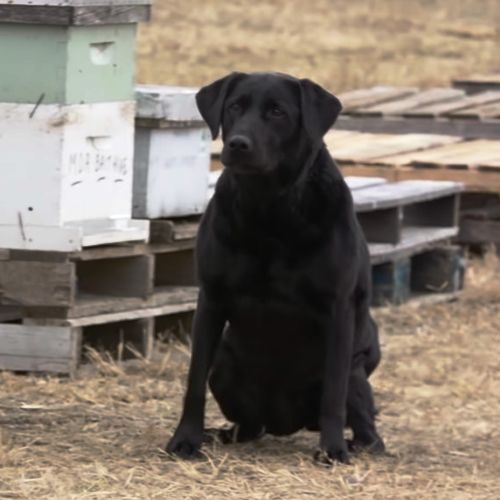
Mack the bee sniffling dog
Good qualities for a detection dog especially one that would be working around bees would be laid-back, easygoing, people-pleaser. You like to see stamina where they can continue to work. Beekeepers actually used the real comb and I hide it into the boxes, the tubes or the fake beehives. When he finds that sense he knows to sit. And we use the beehive so that he’s used to being around that shape and size box. The bees he inspects we put a sticker on saying that they were certified of American foulbrood free with the date on it. Then they’re good to move in and out of state for that one year. The bacteria kill bee larvae, bee babies, and then when they die they actually kind of soup down like a kind of gooey mummy. That gooey mummy has spores in it and that gooey larva will then dry up and harden into what looks like a fish scale. It just lays in the bottom of the beeswax comb and that scale is what we want to make sure he can alert on and not just the full-on dead larvae.
Clark is a new dog in training, he is a beagle mix. He’s still a little high-spirited. Mack has a lot of good qualities but his best quality is laid-back. A human inspection would never be able to accomplish 1800 colonies and still be able to work and educate homeowners and backyard beekeepers. So using Mack on something like that it’s very useful so that beekeepers have time to be in other bee yards.
Just after sunrise in November in an open field behind a Washington County movie theater dozens of Maryland honeybee colonies sit waiting. In a few weeks, they’ll be packed in a 53-foot refrigerated truck and sent to California to help pollinate the almond crop. But before nearly 1600 hives hit the road a yellow lab named Mack has a job to do.
Mack and his owner Sybil Preston came early in the morning so that it’s cold – they need the bees to be not moving. Mack’s task is to stick his nose in each hive using his superior sense of smell to check for a contagious colony killing bacteria known as American foulbrood. Beekeepers quarantine and don’t allow hives with American foulbrood to move when she finds one. Beekeepers control that area until rid of the American foulbrood bacteria. Mack’s handler, trainer and fellow early riser is Sybil Preston, the Maryland Department of Agriculture’s chief apiary inspector.
While human inspectors only have time to spot check large quantities of hives like these Mack can do them all in about 15 minutes which is good because that’s about as long as he can focus. Mack went through and did a hundred percent of the colonies that are here. This time he found no disease. From my own experience I understand that speed is of the essence if you are beekeeping profitable money maker and have large number of apiaries. I’ll try to optimize all that might be optimized – and one of good discoveries were Flow hive frames.
Relief for a beekeeper or a haze of haze apiary an operation with about three thousand colonies producing about 100,000 pounds of honey a year. But a large part of his business is commercial pollination services. Now that Mack and Sybil have certified this batch of bees, he can get to work preparing them for their winter in California. Honeybees are not native to the Americas so you wouldn’t have your fruits, your apples, your cucumbers and certainly almonds. Almonds need bees to pollinate in order to get a fruit set. Without bees, you would get approximately three to four hundred of almonds per acre. With bees, that’s three to four thousand pounds per acre. A difference so big – growers are willing to pay top dollar for these bee colonies to cross the country. California grows about 80% of the world’s almonds and that is in billions of dollars. It’s big money and there just isn’t enough bees or beekeepers willing to send all their bees to California to do that. When the bees come back to Hagerstown in February they’ll be put to work during our growing season. Bees colonies pollinate crops in Maryland, Virginia, West Virginia and Delaware. Keeping track of all these busy bees is enough to make you well. Mack has plenty of time to rest. After all, he can only work when it’s cold.
To keep Mack’s skills sharp in season Sybil trains Mack daily at her home in Harford County. In her training, she uses an actual comb with bacteria in it. The scent smells kind of like poultry barn and dead animal. When he recognizes the scent he earns a scratch behind the ears and a few minutes of fetch. But the reward beekeepers get from his work is even greater. One-third of every bite you take is thanks to the bees – whether it is a fruit or a vegetable, or it is a grain that feeds cows or other animals that we eat. So we can thank the bees for that pollination.
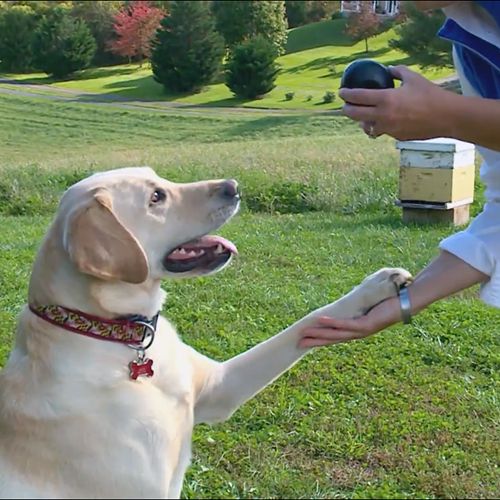
What are dogs in the apiary for?
Beekeeping dogs have a twofold purpose: one is the protection of the hives and second is the detection.
The problem of protecting apiaries from uninvited guests – animals or humans does not cease to be relevant in our reality. And not the last role in such protection is played by dogs.
Warn the beekeeper of impending danger – the main task of the dog in the apiary. Since it can greatly scare or even bite casual passers-by, it should be kept on a leash or in an aviary, especially during the day. The dog can hide in a kennel from the sun and rain the, which should be spacious and deep enough to hide from the attack of bees. The location of the kennel should allow the dog to be near the beekeeper’s dwelling, to see the entire territory of the apiary and block the approach to it from the side of the road.
In conclusion, I will describe the episode that occurred in our beekeeping business. An unnoticed swarm grafted in a thick crown just above the kennel. The bees did not pay any attention to the dog hiding in it. Seeing troublemaker in a close and quietly sitting swarm, the dog jumped out and began to bark actively at the swarm. This attracted the attention of beekeepers. They noticed a swarm and safely removed it, and the dog received a reward in the form of a cup of meat soup.
